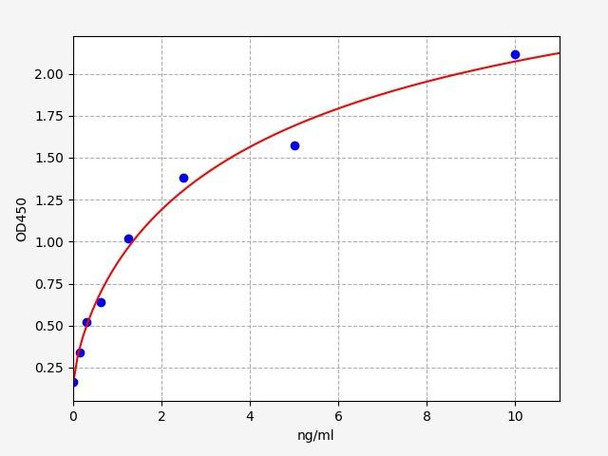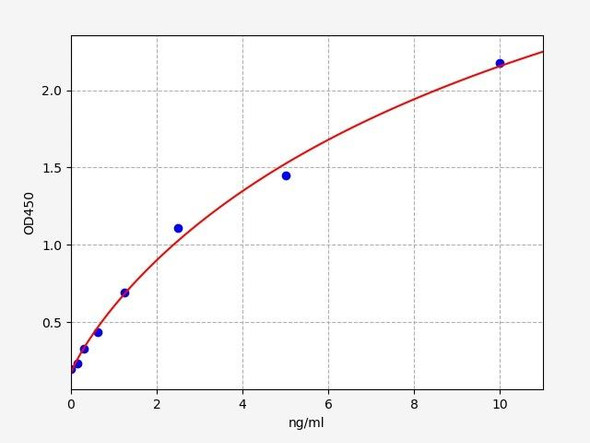Description
Human LRWD1 (Leucine-rich repeat and WD repeat-containing protein 1) ELISA Kit (HUFI03579)
The Human LRWD1 (Leucine Rich Repeat and WD Repeat Containing Protein 1) ELISA Kit is a powerful tool for accurately measuring LRWD1 protein levels in human samples including serum, plasma, and cell culture supernatants. With its high sensitivity and specificity, this kit ensures precise and reproducible results, making it an invaluable resource for a variety of research studies.LRWD1 is a protein with leucine-rich repeats and WD repeats that plays a vital role in various cellular processes including gene expression regulation and protein synthesis.
Dysregulation of LRWD1 has been implicated in several diseases such as cancer, autoimmune disorders, and neurological conditions. Therefore, measuring LRWD1 levels can provide valuable insights into disease mechanisms and potential therapeutic targets.Overall, the Human LRWD1 ELISA Kit offers researchers a reliable tool for studying the function and significance of LRWD1 in different biological contexts, ultimately advancing our understanding of its role in health and disease.
| Product Name: | Human LRWD1 (Leucine-rich repeat and WD repeat-containing protein 1) ELISA Kit |
| Product Code: | HUFI03579 |
| Size: | 96 Assays |
| Alias: | MAPKAP kinase 2 ELISA Kit, MAPKAPK 2 ELISA Kit, MAPKAPK2 ELISA Kit, MK2 ELISA Kit |
| Detection method: | Sandwich ELISA, Double Antibody |
| Application: | This immunoassay kit allows for the in vitro quantitative determination of Human LRWD1 (Leucine-rich repeat and WD repeat-containing protein 1) concentrations in serum plasma and other biological fluids. |
| Sensitivity: | < 0.094ng/ml |
| Range: | 0.156-10ng/ml |
| Storage: | 4°C for 6 months |
| Note: | For Research Use Only |
| Recovery: | Matrices listed below were spiked with certain level of Human LRWD1 (Leucine-rich repeat and WD repeat-containing protein 1) and the recovery rates were calculated by comparing the measured value to the expected amount of Human LRWD1 (Leucine-rich repeat and WD repeat-containing protein 1) in samples. | ||||||||||||||||
| |||||||||||||||||
| Linearity: | The linearity of the kit was assayed by testing samples spiked with appropriate concentration of Human LRWD1 (Leucine-rich repeat and WD repeat-containing protein 1) and their serial dilutions. The results were demonstrated by the percentage of calculated concentration to the expected. | ||||||||||||||||
| |||||||||||||||||
| CV(%): | Intra-Assay: CV<8% Inter-Assay: CV<10% |
| Component | Quantity | Storage |
| ELISA Microplate (Dismountable) | 8×12 strips | 4°C for 6 months |
| Lyophilized Standard | 2 | 4°C/-20°C |
| Sample/Standard Dilution Buffer | 20ml | 4°C |
| Biotin-labeled Antibody(Concentrated) | 120ul | 4°C (Protect from light) |
| Antibody Dilution Buffer | 10ml | 4°C |
| HRP-Streptavidin Conjugate(SABC) | 120ul | 4°C (Protect from light) |
| SABC Dilution Buffer | 10ml | 4°C |
| TMB Substrate | 10ml | 4°C (Protect from light) |
| Stop Solution | 10ml | 4°C |
| Wash Buffer(25X) | 30ml | 4°C |
| Plate Sealer | 5 | - |
Other materials and equipment required:
- Microplate reader with 450 nm wavelength filter
- Multichannel Pipette, Pipette, microcentrifuge tubes and disposable pipette tips
- Incubator
- Deionized or distilled water
- Absorbent paper
- Buffer resevoir
| UniProt Protein Function: | LRWD1: Associated component of the origin recognition complex (ORC) required to recruit and stabilize the ORC complex to chromatin. Probably required for the association of ORC on chromatin during G1 to establish pre-replication complex (preRC) and to heterochromatic sites in post-replicated cells. Binds a combination of DNA and histone methylation repressive marks on heterochromatin: binds histone H3 and H4 trimethylation marks H3K9me3, H3K27me3 and H4K20me3 in a cooperative manner with DNA methylation. It is unclear whether it recongnizes and binds these repressive marks by itself or needs additional factors. Belongs to the LRWD1 family. |
| UniProt Protein Details: | Chromosomal Location of Human Ortholog: 7q22.1 Cellular Component: centric heterochromatin; cytoplasm; microtubule organizing center; nuclear origin of replication recognition complex; nucleus Molecular Function:protein binding; methyl-CpG binding; chromatin binding; methylated histone residue binding Biological Process: establishment and/or maintenance of chromatin architecture; DNA replication initiation; chromatin modification |
| UniProt Code: | Q9UFC0 |
| NCBI GenInfo Identifier: | 23097240 |
| NCBI Gene ID: | 222229 |
| NCBI Accession: | NP_690852.1 |
| UniProt Secondary Accession: | Q9UFC0,Q8N0T9, Q8WV43, Q96GJ2, A8K4K2, B2R9G2, |
| UniProt Related Accession: | Q9UFC0 |
| Molecular Weight: | 70,861 Da |
| NCBI Full Name: | leucine-rich repeat and WD repeat-containing protein 1 |
| NCBI Synonym Full Names: | leucine-rich repeats and WD repeat domain containing 1 |
| NCBI Official Symbol: | LRWD1 |
| NCBI Official Synonym Symbols: | ORCA; CENP-33 |
| NCBI Protein Information: | leucine-rich repeat and WD repeat-containing protein 1; centromere protein 33; ORC-associated protein; origin recognition complex associated; origin recognition complex-associated protein |
| UniProt Protein Name: | Leucine-rich repeat and WD repeat-containing protein 1 |
| UniProt Synonym Protein Names: | Centromere protein 33; CENP-33; Origin recognition complex-associated protein; ORC-associated protein; ORCA |
| Protein Family: | Leucine-rich repeat and WD repeat-containing protein |
| UniProt Gene Name: | LRWD1 |
| UniProt Entry Name: | LRWD1_HUMAN |
*Note: Protocols are specific to each batch/lot. For the correct instructions please follow the protocol included in your kit.
Before adding to wells, equilibrate the SABC working solution and TMB substrate for at least 30 min at 37 °C. When diluting samples and reagents, they must be mixed completely and evenly. It is recommended to plot a standard curve for each test.
| Step | Protocol |
| 1. | Set standard, test sample and control (zero) wells on the pre-coated plate respectively, and then, record their positions. It is recommended to measure each standard and sample in duplicate. Wash plate 2 times before adding standard, sample and control (zero) wells! |
| 2. | Aliquot 0.1ml standard solutions into the standard wells. |
| 3. | Add 0.1 ml of Sample / Standard dilution buffer into the control (zero) well. |
| 4. | Add 0.1 ml of properly diluted sample ( Human serum, plasma, tissue homogenates and other biological fluids.) into test sample wells. |
| 5. | Seal the plate with a cover and incubate at 37 °C for 90 min. |
| 6. | Remove the cover and discard the plate content, clap the plate on the absorbent filter papers or other absorbent material. Do NOT let the wells completely dry at any time. Wash plate X2. |
| 7. | Add 0.1 ml of Biotin- detection antibody working solution into the above wells (standard, test sample & zero wells). Add the solution at the bottom of each well without touching the side wall. |
| 8. | Seal the plate with a cover and incubate at 37 °C for 60 min. |
| 9. | Remove the cover, and wash plate 3 times with Wash buffer. Let wash buffer rest in wells for 1 min between each wash. |
| 10. | Add 0.1 ml of SABC working solution into each well, cover the plate and incubate at 37 °C for 30 min. |
| 11. | Remove the cover and wash plate 5 times with Wash buffer, and each time let the wash buffer stay in the wells for 1-2 min. |
| 12. | Add 90 µL of TMB substrate into each well, cover the plate and incubate at 37 °C in dark within 10-20 min. (Note: This incubation time is for reference use only, the optimal time should be determined by end user.) And the shades of blue can be seen in the first 3-4 wells (with most concentrated standard solutions), the other wells show no obvious color. |
| 13. | Add 50 µL of Stop solution into each well and mix thoroughly. The color changes into yellow immediately. |
| 14. | Read the O.D. absorbance at 450 nm in a microplate reader immediately after adding the stop solution. |
When carrying out an ELISA assay it is important to prepare your samples in order to achieve the best possible results. Below we have a list of procedures for the preparation of samples for different sample types.
| Sample Type | Protocol |
| Serum | If using serum separator tubes, allow samples to clot for 30 minutes at room temperature. Centrifuge for 10 minutes at 1,000x g. Collect the serum fraction and assay promptly or aliquot and store the samples at -80°C. Avoid multiple freeze-thaw cycles. If serum separator tubes are not being used, allow samples to clot overnight at 2-8°C. Centrifuge for 10 minutes at 1,000x g. Remove serum and assay promptly or aliquot and store the samples at -80°C. Avoid multiple freeze-thaw cycles. |
| Plasma | Collect plasma using EDTA or heparin as an anticoagulant. Centrifuge samples at 4°C for 15 mins at 1000 × g within 30 mins of collection. Collect the plasma fraction and assay promptly or aliquot and store the samples at -80°C. Avoid multiple freeze-thaw cycles. Note: Over haemolysed samples are not suitable for use with this kit. |
| Urine & Cerebrospinal Fluid | Collect the urine (mid-stream) in a sterile container, centrifuge for 20 mins at 2000-3000 rpm. Remove supernatant and assay immediately. If any precipitation is detected, repeat the centrifugation step. A similar protocol can be used for cerebrospinal fluid. |
| Cell culture supernatant | Collect the cell culture media by pipette, followed by centrifugation at 4°C for 20 mins at 1500 rpm. Collect the clear supernatant and assay immediately. |
| Cell lysates | Solubilize cells in lysis buffer and allow to sit on ice for 30 minutes. Centrifuge tubes at 14,000 x g for 5 minutes to remove insoluble material. Aliquot the supernatant into a new tube and discard the remaining whole cell extract. Quantify total protein concentration using a total protein assay. Assay immediately or aliquot and store at ≤ -20 °C. |
| Tissue homogenates | The preparation of tissue homogenates will vary depending upon tissue type. Rinse tissue with 1X PBS to remove excess blood & homogenize in 20ml of 1X PBS (including protease inhibitors) and store overnight at ≤ -20°C. Two freeze-thaw cycles are required to break the cell membranes. To further disrupt the cell membranes you can sonicate the samples. Centrifuge homogenates for 5 mins at 5000xg. Remove the supernatant and assay immediately or aliquot and store at -20°C or -80°C. |
| Tissue lysates | Rinse tissue with PBS, cut into 1-2 mm pieces, and homogenize with a tissue homogenizer in PBS. Add an equal volume of RIPA buffer containing protease inhibitors and lyse tissues at room temperature for 30 minutes with gentle agitation. Centrifuge to remove debris. Quantify total protein concentration using a total protein assay. Assay immediately or aliquot and store at ≤ -20 °C. |
| Breast Milk | Collect milk samples and centrifuge at 10,000 x g for 60 min at 4°C. Aliquot the supernatant and assay. For long term use, store samples at -80°C. Minimize freeze/thaw cycles. |










